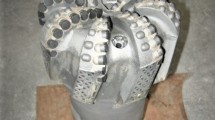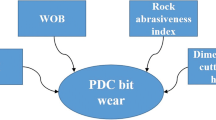The low rate of penetration (ROP) and severe wear of polycrystalline diamond compact (PDC) bits are one of the main problems restricting the exploration of deep oil and gas resources when drilling strongly abrasive formations. As a rock-breaking tool that breaks rocks in the way of diamond exposure, the impregnated diamond bit has the characteristics of high stability, long service life and high drilling speed, which are considered to improve the drilling efficiency of strong abrasive formations. one of the effective ways. However, the drilling parameters and rock abrasiveness of the impregnated drill bit have a very significant impact on the wear rate of the impregnated diamond bit. If the drilling parameters are not designed properly, the bit will be severely worn and the service life will be too low. At the same time, there is a lack of research on the wear equation of diamond-impregnated drill bits, which cannot predict the wear rate of the drill bit and the life of the drill bit well. Therefore, this paper analyzes and summarizes the experimental data of the influence law of drilling parameters and rock abrasiveness coefficient on the wear of impregnated diamond bits, and establishes a formula based on the quantitative relationship between wear rate and WOB per unit area, rotary speed and rock abrasiveness. The impregnated diamond bit wear model provides a theoretical basis for the life prediction of the impregnated diamond bit in field drilling operation.






Similar content being viewed by others
Reference
S. Akhtarmanesh, A. Atashnezhad, G. Hareland, et al. ROP Model for PDC Bits in Geothermal Drilling. 55th U.S. Rock Mechanics/Geomechanics Symposium. 2021.
J. Wu., S. Zhang, X. Ding, et al. Abrasion rule of polycrystalline diamond compact bit cutter. Journal of Failure Analysis and Prevention. 2019;19 (4):1135-1143.
M. Yahiaoui, L. Gerbaud, J-Y. Paris, et al. A study on PDC drill bits quality. Wear. 2013;298:32-41.
M. Yahiaoui, J-Y. Paris, K. Delbé, et al. Quality and wear behavior of graded polycrystalline diamond compact cutters. International Journal of Refractory Metals and Hard Materials. 2016;56:87-95.
Y. Yang. The Study on Wear Regularity, Design and Performance Test of Diamond Bit and Diamond Saw [D]. Central South University, 2004.
R.L. Mehan. Dry sliding wear of diamond materials [J]. Wear, 1982, 78(3):365-383.
D. Miller, A. Ball. The wear of diamonds in impregnated diamond bit drilling [J]. Wear, 1991, 141(2):311-320.
D. M. Busch, J. F. Prins. A basic study of the diamond grinding of alumina [J]. 1972:73-87.
M.W. Bailey, G.J. Bullen. Sawing in the stone and civil engineering industries [J]. IDR, 1979,2:56-60.
L. Duan, F. Tang. Experimental research on the wear of diamond bit in high rpm drilling [J]. Geological Science and Technology Information, 2000, 19(1):109-112.
L. Zheng, J. Tang, S. Li. Performances of Diamond Impregnated Bit in Hole Drilling of Engineering Ceramics [J]. Journal of Anhui University of Science and Technology (Natural Science), 2007, 31(5):574-578.
Ersoy A, M.D. Waller. Wear characteristics of PDC pin and hybrid core bits in rock drilling[J]. Wear, 1995, 188(1-2):150-165.
A.P. Mouritz, IM Hutchings. Abrasive wear of steels against silica-filled epoxy resins under combined rolling and sliding motion. Tribology international. 1993;26 (1):41-47.
H.K. Tönshoff, H. Hillmann-Apmann, J. Asche. Diamond tools in stone and civil engineering industry: cutting principles, wear and applications [J]. Key Engineering Materials, 2003, 250(s 3–6):736-741.
E. Kuru, A.K. Wojtanowsicz. A Method for Detecting In-Situ PDC Bit Dull and Lithology Change. IADC/SPE Drilling Conference. 1988.
G. Hareland, P.R. Rampersad. Drag Bit Model Including Wear. SPE Latin America/Caribbean Petroleum Engineering Conference. 1994.
H.R. Motahhari, G. Hareland, J.A. James. Improved drilling efficiency technique using integrated PDM and PDC bit parameters. Journal of Canadian Petroleum Technology. 2010;49 (10):45-52.
P.B. Kerkar, G. Hareland, E.R. Fonseca, et al. Estimation of Rock Compressive Strength Using Downhole Weight-on-Bit and Drilling Models. International Petroleum Technology Conference. 2014.
J. Cao. Research on Anti-Drilling Characteristics and Increasing Drilling Speed for Marine Formation in the Northeast Area of Sichuan [D]. China University of Petroleum, 2011.
G. Wang. Research on Rock Abrasiveness and Classification of Oil Drilling Strata [D]. China University of Petroleum, 2020.
Acknowledgments
This research work was supported by The Major Science and Technology Projects of CNPC (ZD2019-183-005), The Key Project of National Key R&D Plan Intergovernmental International Scientific Technological Innovation Cooperation (2021YEE0111400), China Postdoctoral Science Foundation funded project (2021M693508), Youth Fund Project of CNPC Engineering Technician Co., Ltd (CPETQ202116), and The Fundamental Research Funds for the Central University (18CX02102A).
Author information
Authors and Affiliations
Corresponding author
Additional information
Translated from Khimiya i Tekhnologiya Topliv i Masel, No. 1, pp. 88–94 January–February, 2023.
Rights and permissions
Springer Nature or its licensor (e.g. a society or other partner) holds exclusive rights to this article under a publishing agreement with the author(s) or other rightsholder(s); author self-archiving of the accepted manuscript version of this article is solely governed by the terms of such publishing agreement and applicable law.
About this article
Cite this article
Liu, X., Zou, D., Yu, J. et al. Experimental Research on the Impregnated Diamond Bit Wear Model. Chem Technol Fuels Oils 59, 113–122 (2023). https://doi.org/10.1007/s10553-023-01509-5
Published:
Issue Date:
DOI: https://doi.org/10.1007/s10553-023-01509-5




